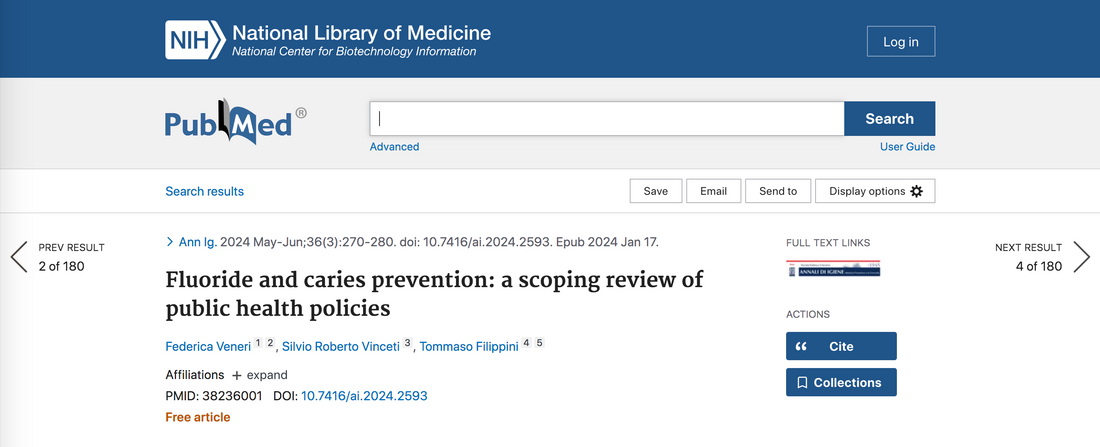Fluoride and Caries Prevention: A Scoping Review of Public Health Policies
Published In: Annali di Igiene: Medicina Preventiva e di Comunità (Ann Ig)
Publication Year: 2024
Study Design
This paper is a scoping review, designed to provide an overview of existing guidelines, policies, and public health considerations concerning fluoride-based caries prevention strategies.
Funding Sources
This study was funded by:
-
PRIN 2022 (no. 2022MHMRPR) and PRIN 2022 PNRR (no. P20229KSXB) from the Italian Ministry of University (EU-funded).
-
UNIMORE FAR 2022 and UNIMORE FAR 2023 from the University of Modena and Reggio Emilia.
-
Fondazione di Modena.
PICO Framework - what was studied and how?
Population:
General populations, particularly children and socioeconomically disadvantaged groups.
Intervention:
Use of fluoride-based preventive strategies including topical and systemic applications (toothpastes, varnishes, fluoridated water, supplements).
Comparison:
Non-fluoride-based interventions or systemic fluoride delivery methods vs topical fluoride strategies.
Outcomes:
-
Reduction in dental caries incidence.
-
Evaluation of public health risks and benefits, including fluorosis and systemic effects.
-
Recommendations for public health policies and access to care.
In Paragraph Form:
This review examined fluoride-based strategies for preventing dental caries across diverse populations, especially vulnerable groups. It compared systemic and topical fluoride approaches, assessing their effectiveness, potential adverse effects, and implications for public health law and policy. The goal was to recommend optimal fluoride use to reduce caries while minimizing health risks and promoting equitable access.
Inclusion and Exclusion Criteria
Inclusion Criteria:
-
Policy documents, guidelines, position papers, and systematic reviews from major health organizations.
-
Research related to fluoride use in caries prevention and public health law.
Exclusion Criteria:
-
Primary studies not addressing policy or guideline implications.
-
Non-fluoride-based dental interventions.
Demographics and Study Design
As a scoping review, there were no patient cohorts. The authors synthesized data from:
-
Global public health guidelines.
-
Systematic reviews and meta-analyses.
-
Policy positions of key dental and public health institutions.
Primary Outcome Variables and Results
Key Outcomes:
-
Topical fluorides (toothpaste, varnishes) are more effective and safer than systemic fluorides (water fluoridation, supplements).
-
Excessive systemic fluoride, especially in children, is linked to dental fluorosis, skeletal fluorosis, and potential neurodevelopmental and thyroid effects.
-
Topical fluoride use in children reduces caries incidence significantly with proper dosing and supervision.
Statistical Highlights:
-
Caries reduction with community water fluoridation: 25–60% (historically).
-
Fluorosis prevalence with 0.7 mg/L fluoride in water: 12% (aesthetic concern level).
Conclusions
Topical fluoride is the preferred method for preventing dental caries due to its superior risk-benefit profile. Systemic fluoride should be used cautiously, considering cumulative intake. Public health policies must prioritize access to safe and affordable topical fluoride products, especially in underserved communities.
Discussion: Strengths and Limitations
Strengths:
-
Comprehensive synthesis of global public health guidance.
-
Integrates scientific, legal, and policy perspectives.
-
Highlights equity and access issues in oral health.
Weaknesses:
-
Scoping review nature limits quantitative meta-analysis.
-
Does not include new experimental data.
-
Policy recommendations may vary in applicability across regions.
Citation
Veneri F, Vinceti SR, Filippini T. Fluoride and caries prevention: a scoping review of public health policies. Ann Ig. 2024;36(3):270–280. doi:10.7416/ai.2024.2593
🔗 Link to article
Visual Aids
Simple Chart: Effectiveness and Risks of Fluoride Strategies
| Fluoride Method | Effectiveness (Caries Reduction) | Key Risks | Recommended Use |
|---|---|---|---|
| Topical (Toothpaste/Varnish) | High | Minimal (with supervision) | Universal, all ages |
| Water Fluoridation | Moderate (25–60%) historically | Dental/Skeletal Fluorosis, Controversial | With caution, based on risk-benefit |
| Supplements (Drops/Tablets) | Limited | Overexposure risk, not broadly advised | Only in high-risk with low fluoride access |


